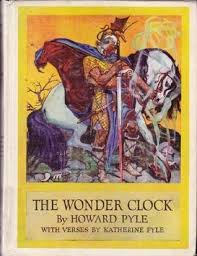Howard Pyle
Listen to the Recess! Clip
| Author | Rita Smith |
| Air Date | 3/7/2001 |

Howard Pyle Transcript
Way back in 1877, American children going through their latest issues of St. Nicholas Magazine discovered some little fables with illustrations quite different from those to which they were accustomed. These simple drawings had a strong, heavy line, and a quaint, kindly humor and were signed with a modest “H.P.”
Thirty years later, these children would still be enjoying fresh illustrations by this artist, Howard Pyle, who revolutionized American book illustration, first through his own talents and skills, and later through his pupils, who included Maxfield Parrish, Jessie Wilcox Smith and N.C. Wyeth.
The Merry Adventures of Robin Hood, published in 1883, established Pyle as one of America’s leading children’s authors and artists. He followed it with two collections of original short fairy stories, Pepper and Salt and The Wonder Clock. The illustrations for these two books “form a perfect complement to the stories. They exhibit the same superb sense of form, the same fitting selection of detail, the same power of imagination, and the same humor and action, as do the stories. They are storied pictures, and completely fulfill Pyle’s theories that illustration should first of all tell a story and tell some phase of it better than written words do and second, that illustration is not merely decoration, but [the] objectification of thought and feeling. 1
After the fairy stories, Pyle wrote and illustrated several historical novels, and in 1902 he began the huge task of writing and illustrating his own version of the Arthurian legends; King Arthur and His Knights came out in 1903 and was followed by three further volumes completing the series. His illustrations in these books were filled with gaiety, light and action. Here were spacious castles “with balconies and tiled roofs where pigeons strutted joyfully in the sun; stone-paved courtyards filled with activity. Here were rollicking dogs, handsome princes, clever peasant lads and stout jolly priests, as handy with staff or cudgel as with the ale mug; ready to drub a villain or perform a miracle with equal good humor.
Pyle was a great innovator whose stories and illustrations opened up a fresh new world to American children and he was very happy to have accomplished that. Toward the end of his life, he wrote, “My ambition in days gone by was to write a really notable adult book, but now I am glad that I have made literary friends of the children. In one’s mature years, one forgets the books that one reads, but the stories of childhood leave an indelible impression, and their author always has a niche in the temple of memory from which the image is never cast out into the rubbish-heap of things that are outgrown and outlived.”2
1 A Critical History of Children’s Literature , p. 279.
2 Ibid., p. 287.
Sources:
Dalby, Richard. The Golden Age of Children’s Book Illustration. New York: Gallery Books, 1991.
A Critical History of Children’s Literature; a Survey of Children’s books in English, prepared in four parts under the editorship of Cornelia Meigs. Revised Edition. New York: The Macmillan Company, 1969.
Carpenter, Humphrey and Mari Prichard. The Oxford Companion to Children’s Literature. Oxford and New York: Oxford University Press, 1984.
Illustrators of Children’s Books, 1744-1945. Compiled by Bertha E. Mahoney, Louise Payson Latimer and Beulah Folmsbee. Boston: The Horn Book, 1947.